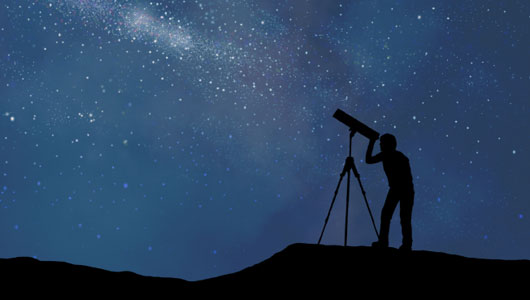We use constellations with signs of the zodiac or animals, because these are convenient easy ways of helping to remember where particular stars are. We name the constellations for the shapes their stars make when joined up. Cygnus is in the shape of a swan with wings outstretched, and Scorpius is shaped like a scorpion. Sometimes a shape will be part of a constellation, such as the seven bright stars in Ursa Major that form the saucepan and handle of the Big Dipper.
Category: Observing
Effective Deep-Sky Observing
 If you’ve ever looked at a bright star through a telescope, it will look much brighter and spectacular, but not contain any detail. It’s still a point of light. Much more fascinating and challenging is to focus your telescope on deep-sky objects such as star clusters, nebulae and galaxies. Many of these can be seen through any reasonable small telescope.
If you’ve ever looked at a bright star through a telescope, it will look much brighter and spectacular, but not contain any detail. It’s still a point of light. Much more fascinating and challenging is to focus your telescope on deep-sky objects such as star clusters, nebulae and galaxies. Many of these can be seen through any reasonable small telescope.
But on first sight the galaxy or nebulae you’ve chosen may be unimpressive, just a sort of indistinct, grey cloud with only a few lonely stars visible, like oases in a desert. The problem is the human eye’s inability to see well at night. It can be very disappointing to see such brilliant, colorful images in astronomy books and magazines, and then observe very little through the telescope.
Stars According to Their Spectral Types
We tend to think of the brightness or apparent magnitude of stars and their location in the sky to be the most important thing to know about them. But there is much more to them, and if you make yourself aware of their characteristics, it will certainly enhance your enjoyment of stargazing.
Urban Astronomy
If you have been in the country far from any human-made light source you will know that the night sky is a wondrous, luminous marvel, the sky ablaze with light. Bright stars and planets are caught in a glowing net of dimmer stars and nebulae.
Variable and Double Stars
Variable and double stars can be very difficult to see even with a good telescope – large observatory telescopes and the Hubble Telescope in Earth’s orbit, tend to be better at distinguishing between stars at extreme proximity compared with their distance from us.
Starting Out as an Amateur Astronomer
 So you’ve bought your telescope or binoculars and you know how it works. You’ve done a bit reading on the subject of astronomy. It’s time to get out and do a bit of observing! But where to start? You have read about all those planets and stars out there, but how do know which are visible tonight? Although you may read about the subject it’s hard to get an understanding of the night sky without actually looking at it. And the problem is it’s changing all the time, with each passing hour and day. The sky at 8pm tomorrow will look slightly different from the same time tonight. Most star charts are no more than monthly, which can make it difficult for the astronomer starting out.
So you’ve bought your telescope or binoculars and you know how it works. You’ve done a bit reading on the subject of astronomy. It’s time to get out and do a bit of observing! But where to start? You have read about all those planets and stars out there, but how do know which are visible tonight? Although you may read about the subject it’s hard to get an understanding of the night sky without actually looking at it. And the problem is it’s changing all the time, with each passing hour and day. The sky at 8pm tomorrow will look slightly different from the same time tonight. Most star charts are no more than monthly, which can make it difficult for the astronomer starting out.
Binocular Observing
 When you think of amateur astronomy or stargazing you automatically think that you will need to buy a telescope. But this isn’t necessarily true. A good quality telescope is expensive and can be hard to use effectively, especially if you’re the type of person who has trouble keeping your hands steady. You can use a stand but that’s more expense.
When you think of amateur astronomy or stargazing you automatically think that you will need to buy a telescope. But this isn’t necessarily true. A good quality telescope is expensive and can be hard to use effectively, especially if you’re the type of person who has trouble keeping your hands steady. You can use a stand but that’s more expense.
Kids especially have trouble with large, bulky telescopes. Forget about cheap telescopes, as these tend to produce dim images and false colors.
Amateur Astronomy on a Budget
Amateur astronomy can be an expensive business, especially if you want a really good quality telescope. Some, such as the Ritchey-Chrétien can be cost in the range of $2000-$6000 dollars. Even some refractors can be over $1000.Yet it needn’t cost you that much – you can pick up a new telescope for less than $200 from reputable dealers. But before buying any telescope you need to make sure it will do the job – especially for amateur astronomy, which is much more demanding than any terrestrial observation.





